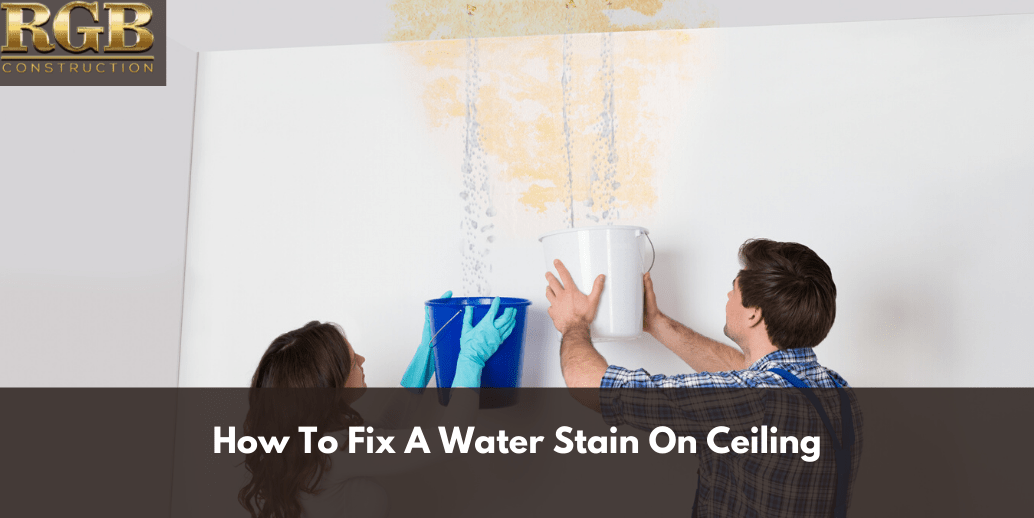A water stain on a ceiling can be pretty unsightly. It seems as though every time you look at the stain, it gets more discolored and more massive, while it spreads and lingers across your ceiling. The problem is, it doesn’t magically disappear, and that means the stain is only going to get worse. The real trick is not to think it is going to disappear but, at the same time, don’t go full force and cover or paint over the stain. Think logically, which means locate the source, repair it then cover it. So what can be done to fix a water stain on a ceiling?
Locate the Leak’s Origin
With any water stain, the first thing you want to do is find the origin or source of the leak. Leaks that create ceiling stains usually come from a roof area or an upper-level bathroom. Anything directly above a ceiling is likely going to be the source of the problem.
Besides a roof or bathroom leak, water stains can come from heating devices, faulty plumbing, deteriorating caulking, and shower pans. More stains can originate from water that may have been carried along pipes or rafters before it deposited itself on a ceiling. Deteriorating or old caulking is another source of seepage, as are pipes, or even shower pans that are in bad condition. If proper insulation is lacking around piping that is in disrepair, leaks can result from that situation. If pipes have gone beyond their usefulness, it may be time to replace them. This is especially true if hard water has prematurely damaged them, and leaks are present.
Roof Origins
Any water stains that are coming from the roof area need to be located and evaluated for repair. Besides direct water seepage that comes from a roof, other sources can originate from accumulated snow and subsequent ice dams. If this is the case, an upgrade in insulation is needed. With all these if’s and possible origins of leaks and water stains, it may be necessary to call in a roofing specialist to resolve the issues. The contractor will be better able to solve the dilemma with an overall idea of what’s happening through your input.
Other Preventative Measures
There are other preventative measures you can take to keep water stains from ruining your ceilings. For one, utilize a water softener if hard water has overtaken your pipes. Scrape out and get rid of old caulking before you put in a new thickness. Most importantly, do an inspection yourself of your entire roof system, or bring in a professional to take a hard look.
Solving the Water Stain Dilemma
Before you try to alleviate the stain, leave any damaged drywall or plaster alone until the moisture situation has been resolved. You don’t want leaks to continue once you have made any major repairs.
When you are positive that the leak is no longer active, you may have to tear out the ceiling or wall area that has been damaged by the water stain. Proceed with caution with removal as any wet ceiling drywall or plaster can be dangerous to anyone underneath or near it if it falls. When that kind of damage is involved, the assistance of a professional roofer, drywall installer, or handyman may be required. They can repair the areas in question with new drywall or plaster along with any taping and texture work. If the stain is indeed cosmetic, it will require the use of a primer that kills the stain first. This may require several coats. Once dry, the area should be repainted. You don’t want the stain to reappear, so it is essential to use the primer.
Cleaning, Priming and Painting
When you have a stained ceiling area that hasn’t been totally destroyed or weakened, and all repairs have been made, you can clean the spot with a mild bleach solution. This will fade the stain as well as get rid of any dirt, dust, grease, or mildew. Make sure you have a spray water bottle handy as well as plastic gloves and some type of eye protection along with a drop cloth to use under the area. Use a large, durable sponge and start with wiping the stained area with the bleach solution. Rinse the stained area with spray from the water bottle and wipe the spot clean with a cloth. Once dry, use removable painter’s tape around the area beyond the ceiling stain to keep those areas protected from any excess paint or paint splatters.
Now, you’re ready to use an oil-based mold and stain resistant primer to paint over the ceiling area, using a color that best matches the old ceiling paint. Apply with either a roller or spray if there is texture to the ceiling. Once primed and dry, paint over the area with either a faster drying latex paint or an oil-based paint. Two coats should do it, and hopefully, your ceiling will be good as new again.
A water stain on a ceiling is not something to ignore, and it will only get worse without attention. If you feel you are unable to deal with the stain and repair work yourself or have more questions concerning the steps to repair it, complete the online contact form and an expert will return your inquiry as soon as possible.







